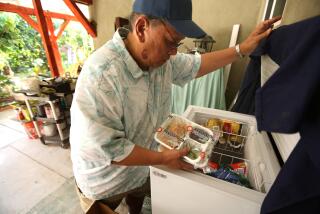Brea : Special Program Meets Needs of Frail, Elderly
- Share via
Dorothy Oakes’ eyes moisten a little as she talks about an elderly woman she met in the course of her job as case worker for the Brea Case Management Program.
“She had fallen and had been on the floor for three days. People would call, but she had Parkinson’s Disease and couldn’t even get up to answer the phone,” Oakes recalled. “She had rug burns all over her arms and face from pulling herself along the ground.”
Oakes smiled. “Now she’s back here (at the Brea Senior Center) and plays in the Kitchen Band. They’re making guest appearances all over town.”
To two other Brea residents, Clara, 90, and Anna, 78, Oakes is “our miracle maker.” When Clara, who is homebound, lost her husband, she let Oakes know that she would like a companion near her age to share her neat, yellow stucco home.
Workers at the Brea Senior Center introduced the two, and, as Anna put it, “it was like when you pick up the pieces of a jigsaw puzzle and put them together. We got together right away.”
The two have shared Clara’s home since August. As she has done for almost 300 other clients, Oakes discussed their needs with them and arranged for volunteers--primarily other seniors--to deliver meals, clean the house, choose library books and take them to the doctor. Others keep in touch by telephone.
The Case Management Program was created in 1979 to serve what Brea Senior Center director Margo Mohn calls the “frail elderly.”
For the about 160 Brea residents who are over 60 years old and too weak or debilitated to meet all their own basic needs, the service is often all that stands between them and institutionalization.
Brea has no convalescent hospitals or retirement homes, so the aid Oakes coordinates often means an elderly person is saved from having to move to a new community altogether.
The Brea program, which is modeled after a similar program in San Clemente, is administered by Orange County. Its budget grew from an original $20,000 to $26,000 in 1984-85, but the federal funds on which it relies have been frozen for 1985-86.
The program is probably unique in one respect, however: virtually all of Mohn’s requests for supplemental city funding have been granted.
“Our City Council members know these residents. It’s an old community, so these people are faces and names when it comes to asking for money,” she said.
The hurdles those “faces and names” must surmount to remain independent can sometimes be formidable. With rents in Brea between $310 and $610 for a one-bedroom apartment, and $325 to $495 a month for space in a trailer park, many seniors have trouble finding housing. Others need help adjusting to the death of a spouse, or are simply lonely.
In January, Oakes and Mohn also plan to start a group of “caring companions,” to supplement the work of the homemakers. If the city funds they are hoping for become a reality, these trained volunteers will act as friendly listeners and companions for homebound seniors.
Oakes’ clients are not the only ones who benefit from the services, however. She recalled the time she was trying to escape from the office around 5:30 one Friday afternoon, when she stopped to answer a ringing phone.
It was an elderly man who needed a ride to an emergency doctor’s appointment the next day. Thinking she might have trouble filling the need on such short notice, she called one of her volunteers, who, without hesitation, said he would help out.
“I talked to that volunteer on Monday,” Oakes said. “He had gotten a call . . . the next morning saying his father had died. He said how good it made him feel that he had been able to do something for that man, for someone else’s father.”
More to Read
Sign up for Essential California
The most important California stories and recommendations in your inbox every morning.
You may occasionally receive promotional content from the Los Angeles Times.










